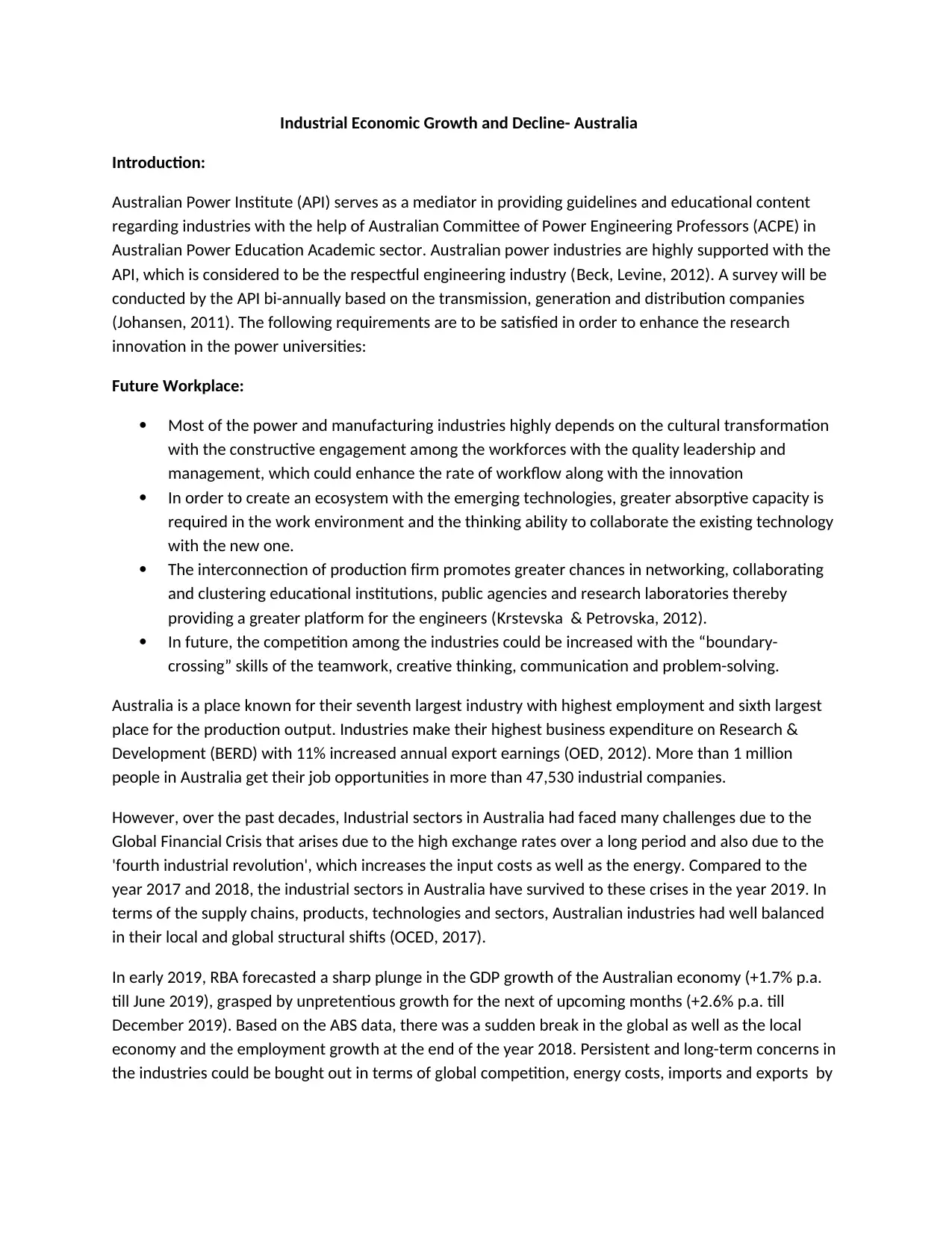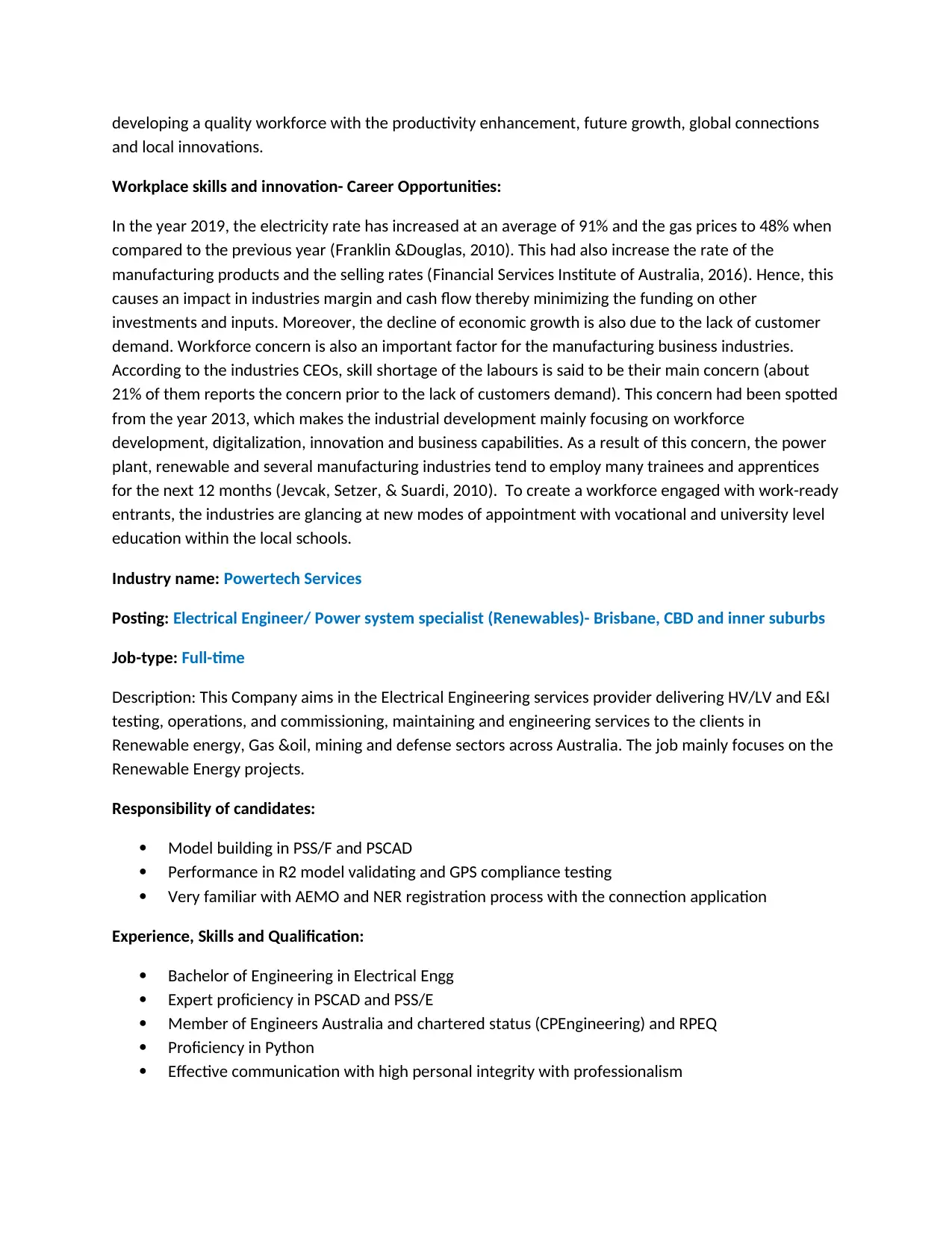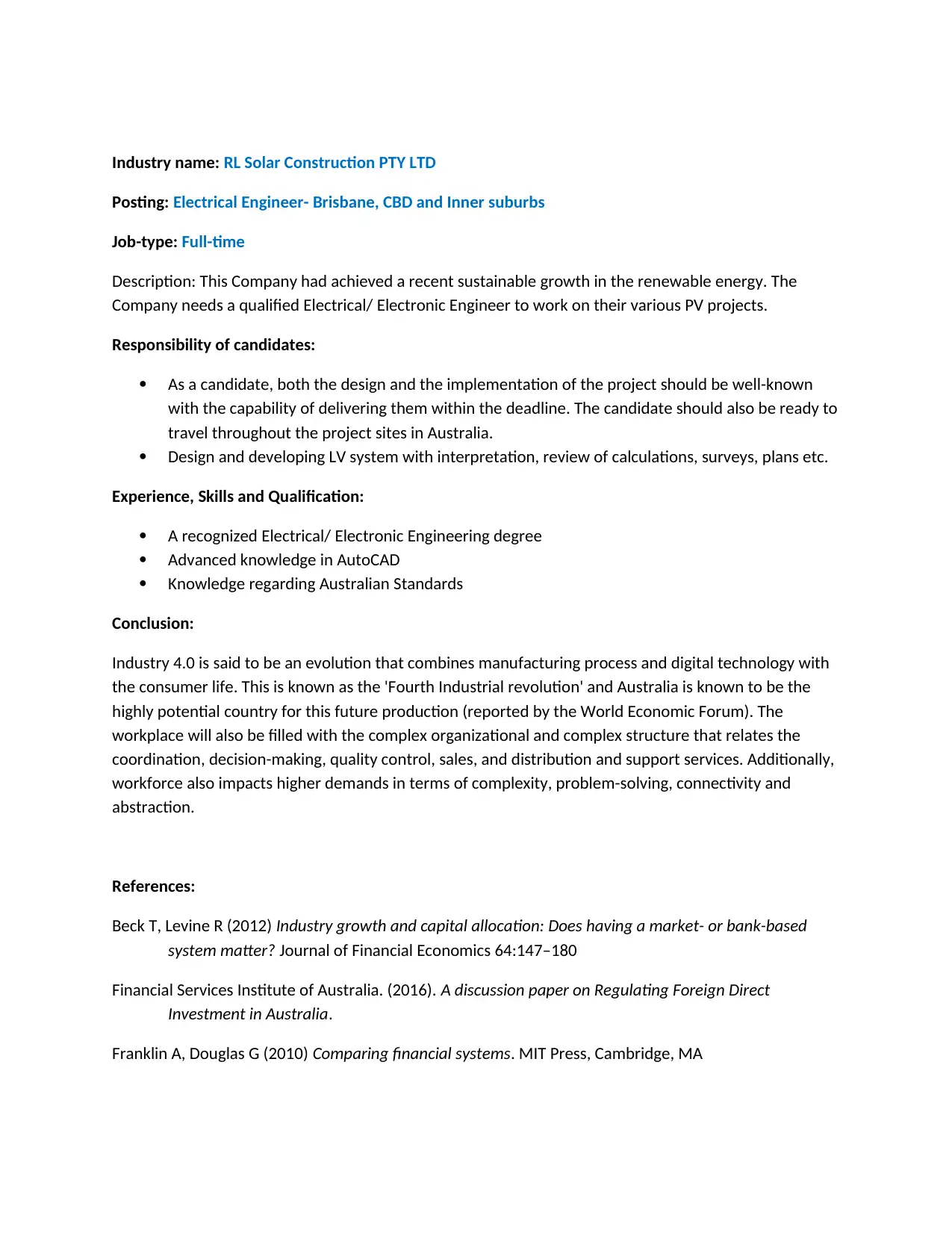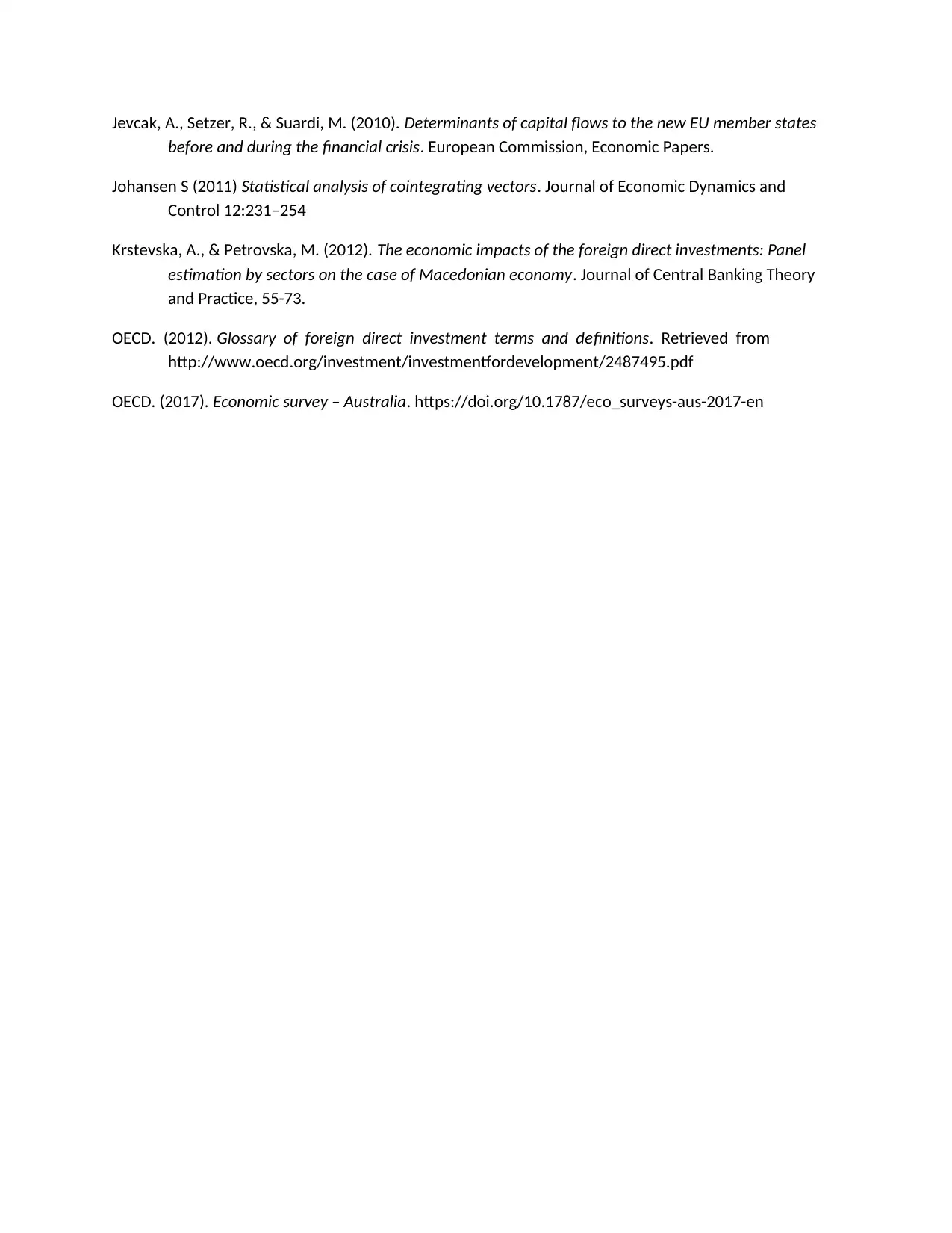Analysis of Australian Industrial Economic Growth and Decline Report
VerifiedAdded on 2022/08/20
|4
|1396
|25
Report
AI Summary
This report, prepared for the Australian Power Institute (API), examines the economic growth and decline of the industrial sector in Australia. It explores the challenges faced by industries, including the impact of the Global Financial Crisis, high exchange rates, and the 'fourth industrial revolution,' while also highlighting the sector's resilience and adaptation. The report analyzes the impact of rising electricity and gas prices on manufacturing and customer demand, as well as workforce concerns, especially skill shortages. It presents job postings for electrical engineers and power system specialists in the renewable energy sector and concludes with a discussion of Industry 4.0's impact on the future of manufacturing, emphasizing the importance of workforce skills, innovation, and digital technology. The report references several academic and industry sources to support its findings, providing a comprehensive overview of the current state and future prospects of the Australian industrial landscape.

Industrial Economic Growth and Decline- Australia
Introduction:
Australian Power Institute (API) serves as a mediator in providing guidelines and educational content
regarding industries with the help of Australian Committee of Power Engineering Professors (ACPE) in
Australian Power Education Academic sector. Australian power industries are highly supported with the
API, which is considered to be the respectful engineering industry (Beck, Levine, 2012). A survey will be
conducted by the API bi-annually based on the transmission, generation and distribution companies
(Johansen, 2011). The following requirements are to be satisfied in order to enhance the research
innovation in the power universities:
Future Workplace:
Most of the power and manufacturing industries highly depends on the cultural transformation
with the constructive engagement among the workforces with the quality leadership and
management, which could enhance the rate of workflow along with the innovation
In order to create an ecosystem with the emerging technologies, greater absorptive capacity is
required in the work environment and the thinking ability to collaborate the existing technology
with the new one.
The interconnection of production firm promotes greater chances in networking, collaborating
and clustering educational institutions, public agencies and research laboratories thereby
providing a greater platform for the engineers (Krstevska & Petrovska, 2012).
In future, the competition among the industries could be increased with the “boundary-
crossing” skills of the teamwork, creative thinking, communication and problem-solving.
Australia is a place known for their seventh largest industry with highest employment and sixth largest
place for the production output. Industries make their highest business expenditure on Research &
Development (BERD) with 11% increased annual export earnings (OED, 2012). More than 1 million
people in Australia get their job opportunities in more than 47,530 industrial companies.
However, over the past decades, Industrial sectors in Australia had faced many challenges due to the
Global Financial Crisis that arises due to the high exchange rates over a long period and also due to the
'fourth industrial revolution', which increases the input costs as well as the energy. Compared to the
year 2017 and 2018, the industrial sectors in Australia have survived to these crises in the year 2019. In
terms of the supply chains, products, technologies and sectors, Australian industries had well balanced
in their local and global structural shifts (OCED, 2017).
In early 2019, RBA forecasted a sharp plunge in the GDP growth of the Australian economy (+1.7% p.a.
till June 2019), grasped by unpretentious growth for the next of upcoming months (+2.6% p.a. till
December 2019). Based on the ABS data, there was a sudden break in the global as well as the local
economy and the employment growth at the end of the year 2018. Persistent and long-term concerns in
the industries could be bought out in terms of global competition, energy costs, imports and exports by
Introduction:
Australian Power Institute (API) serves as a mediator in providing guidelines and educational content
regarding industries with the help of Australian Committee of Power Engineering Professors (ACPE) in
Australian Power Education Academic sector. Australian power industries are highly supported with the
API, which is considered to be the respectful engineering industry (Beck, Levine, 2012). A survey will be
conducted by the API bi-annually based on the transmission, generation and distribution companies
(Johansen, 2011). The following requirements are to be satisfied in order to enhance the research
innovation in the power universities:
Future Workplace:
Most of the power and manufacturing industries highly depends on the cultural transformation
with the constructive engagement among the workforces with the quality leadership and
management, which could enhance the rate of workflow along with the innovation
In order to create an ecosystem with the emerging technologies, greater absorptive capacity is
required in the work environment and the thinking ability to collaborate the existing technology
with the new one.
The interconnection of production firm promotes greater chances in networking, collaborating
and clustering educational institutions, public agencies and research laboratories thereby
providing a greater platform for the engineers (Krstevska & Petrovska, 2012).
In future, the competition among the industries could be increased with the “boundary-
crossing” skills of the teamwork, creative thinking, communication and problem-solving.
Australia is a place known for their seventh largest industry with highest employment and sixth largest
place for the production output. Industries make their highest business expenditure on Research &
Development (BERD) with 11% increased annual export earnings (OED, 2012). More than 1 million
people in Australia get their job opportunities in more than 47,530 industrial companies.
However, over the past decades, Industrial sectors in Australia had faced many challenges due to the
Global Financial Crisis that arises due to the high exchange rates over a long period and also due to the
'fourth industrial revolution', which increases the input costs as well as the energy. Compared to the
year 2017 and 2018, the industrial sectors in Australia have survived to these crises in the year 2019. In
terms of the supply chains, products, technologies and sectors, Australian industries had well balanced
in their local and global structural shifts (OCED, 2017).
In early 2019, RBA forecasted a sharp plunge in the GDP growth of the Australian economy (+1.7% p.a.
till June 2019), grasped by unpretentious growth for the next of upcoming months (+2.6% p.a. till
December 2019). Based on the ABS data, there was a sudden break in the global as well as the local
economy and the employment growth at the end of the year 2018. Persistent and long-term concerns in
the industries could be bought out in terms of global competition, energy costs, imports and exports by
Paraphrase This Document
Need a fresh take? Get an instant paraphrase of this document with our AI Paraphraser

developing a quality workforce with the productivity enhancement, future growth, global connections
and local innovations.
Workplace skills and innovation- Career Opportunities:
In the year 2019, the electricity rate has increased at an average of 91% and the gas prices to 48% when
compared to the previous year (Franklin &Douglas, 2010). This had also increase the rate of the
manufacturing products and the selling rates (Financial Services Institute of Australia, 2016). Hence, this
causes an impact in industries margin and cash flow thereby minimizing the funding on other
investments and inputs. Moreover, the decline of economic growth is also due to the lack of customer
demand. Workforce concern is also an important factor for the manufacturing business industries.
According to the industries CEOs, skill shortage of the labours is said to be their main concern (about
21% of them reports the concern prior to the lack of customers demand). This concern had been spotted
from the year 2013, which makes the industrial development mainly focusing on workforce
development, digitalization, innovation and business capabilities. As a result of this concern, the power
plant, renewable and several manufacturing industries tend to employ many trainees and apprentices
for the next 12 months (Jevcak, Setzer, & Suardi, 2010). To create a workforce engaged with work-ready
entrants, the industries are glancing at new modes of appointment with vocational and university level
education within the local schools.
Industry name: Powertech Services
Posting: Electrical Engineer/ Power system specialist (Renewables)- Brisbane, CBD and inner suburbs
Job-type: Full-time
Description: This Company aims in the Electrical Engineering services provider delivering HV/LV and E&I
testing, operations, and commissioning, maintaining and engineering services to the clients in
Renewable energy, Gas &oil, mining and defense sectors across Australia. The job mainly focuses on the
Renewable Energy projects.
Responsibility of candidates:
Model building in PSS/F and PSCAD
Performance in R2 model validating and GPS compliance testing
Very familiar with AEMO and NER registration process with the connection application
Experience, Skills and Qualification:
Bachelor of Engineering in Electrical Engg
Expert proficiency in PSCAD and PSS/E
Member of Engineers Australia and chartered status (CPEngineering) and RPEQ
Proficiency in Python
Effective communication with high personal integrity with professionalism
and local innovations.
Workplace skills and innovation- Career Opportunities:
In the year 2019, the electricity rate has increased at an average of 91% and the gas prices to 48% when
compared to the previous year (Franklin &Douglas, 2010). This had also increase the rate of the
manufacturing products and the selling rates (Financial Services Institute of Australia, 2016). Hence, this
causes an impact in industries margin and cash flow thereby minimizing the funding on other
investments and inputs. Moreover, the decline of economic growth is also due to the lack of customer
demand. Workforce concern is also an important factor for the manufacturing business industries.
According to the industries CEOs, skill shortage of the labours is said to be their main concern (about
21% of them reports the concern prior to the lack of customers demand). This concern had been spotted
from the year 2013, which makes the industrial development mainly focusing on workforce
development, digitalization, innovation and business capabilities. As a result of this concern, the power
plant, renewable and several manufacturing industries tend to employ many trainees and apprentices
for the next 12 months (Jevcak, Setzer, & Suardi, 2010). To create a workforce engaged with work-ready
entrants, the industries are glancing at new modes of appointment with vocational and university level
education within the local schools.
Industry name: Powertech Services
Posting: Electrical Engineer/ Power system specialist (Renewables)- Brisbane, CBD and inner suburbs
Job-type: Full-time
Description: This Company aims in the Electrical Engineering services provider delivering HV/LV and E&I
testing, operations, and commissioning, maintaining and engineering services to the clients in
Renewable energy, Gas &oil, mining and defense sectors across Australia. The job mainly focuses on the
Renewable Energy projects.
Responsibility of candidates:
Model building in PSS/F and PSCAD
Performance in R2 model validating and GPS compliance testing
Very familiar with AEMO and NER registration process with the connection application
Experience, Skills and Qualification:
Bachelor of Engineering in Electrical Engg
Expert proficiency in PSCAD and PSS/E
Member of Engineers Australia and chartered status (CPEngineering) and RPEQ
Proficiency in Python
Effective communication with high personal integrity with professionalism

Industry name: RL Solar Construction PTY LTD
Posting: Electrical Engineer- Brisbane, CBD and Inner suburbs
Job-type: Full-time
Description: This Company had achieved a recent sustainable growth in the renewable energy. The
Company needs a qualified Electrical/ Electronic Engineer to work on their various PV projects.
Responsibility of candidates:
As a candidate, both the design and the implementation of the project should be well-known
with the capability of delivering them within the deadline. The candidate should also be ready to
travel throughout the project sites in Australia.
Design and developing LV system with interpretation, review of calculations, surveys, plans etc.
Experience, Skills and Qualification:
A recognized Electrical/ Electronic Engineering degree
Advanced knowledge in AutoCAD
Knowledge regarding Australian Standards
Conclusion:
Industry 4.0 is said to be an evolution that combines manufacturing process and digital technology with
the consumer life. This is known as the 'Fourth Industrial revolution' and Australia is known to be the
highly potential country for this future production (reported by the World Economic Forum). The
workplace will also be filled with the complex organizational and complex structure that relates the
coordination, decision-making, quality control, sales, and distribution and support services. Additionally,
workforce also impacts higher demands in terms of complexity, problem-solving, connectivity and
abstraction.
References:
Beck T, Levine R (2012) Industry growth and capital allocation: Does having a market- or bank-based
system matter? Journal of Financial Economics 64:147–180
Financial Services Institute of Australia. (2016). A discussion paper on Regulating Foreign Direct
Investment in Australia.
Franklin A, Douglas G (2010) Comparing financial systems. MIT Press, Cambridge, MA
Posting: Electrical Engineer- Brisbane, CBD and Inner suburbs
Job-type: Full-time
Description: This Company had achieved a recent sustainable growth in the renewable energy. The
Company needs a qualified Electrical/ Electronic Engineer to work on their various PV projects.
Responsibility of candidates:
As a candidate, both the design and the implementation of the project should be well-known
with the capability of delivering them within the deadline. The candidate should also be ready to
travel throughout the project sites in Australia.
Design and developing LV system with interpretation, review of calculations, surveys, plans etc.
Experience, Skills and Qualification:
A recognized Electrical/ Electronic Engineering degree
Advanced knowledge in AutoCAD
Knowledge regarding Australian Standards
Conclusion:
Industry 4.0 is said to be an evolution that combines manufacturing process and digital technology with
the consumer life. This is known as the 'Fourth Industrial revolution' and Australia is known to be the
highly potential country for this future production (reported by the World Economic Forum). The
workplace will also be filled with the complex organizational and complex structure that relates the
coordination, decision-making, quality control, sales, and distribution and support services. Additionally,
workforce also impacts higher demands in terms of complexity, problem-solving, connectivity and
abstraction.
References:
Beck T, Levine R (2012) Industry growth and capital allocation: Does having a market- or bank-based
system matter? Journal of Financial Economics 64:147–180
Financial Services Institute of Australia. (2016). A discussion paper on Regulating Foreign Direct
Investment in Australia.
Franklin A, Douglas G (2010) Comparing financial systems. MIT Press, Cambridge, MA
⊘ This is a preview!⊘
Do you want full access?
Subscribe today to unlock all pages.

Trusted by 1+ million students worldwide

Jevcak, A., Setzer, R., & Suardi, M. (2010). Determinants of capital flows to the new EU member states
before and during the financial crisis. European Commission, Economic Papers.
Johansen S (2011) Statistical analysis of cointegrating vectors. Journal of Economic Dynamics and
Control 12:231–254
Krstevska, A., & Petrovska, M. (2012). The economic impacts of the foreign direct investments: Panel
estimation by sectors on the case of Macedonian economy. Journal of Central Banking Theory
and Practice, 55-73.
OECD. (2012). Glossary of foreign direct investment terms and definitions. Retrieved from
http://www.oecd.org/investment/investmentfordevelopment/2487495.pdf
OECD. (2017). Economic survey – Australia. https://doi.org/10.1787/eco_surveys-aus-2017-en
before and during the financial crisis. European Commission, Economic Papers.
Johansen S (2011) Statistical analysis of cointegrating vectors. Journal of Economic Dynamics and
Control 12:231–254
Krstevska, A., & Petrovska, M. (2012). The economic impacts of the foreign direct investments: Panel
estimation by sectors on the case of Macedonian economy. Journal of Central Banking Theory
and Practice, 55-73.
OECD. (2012). Glossary of foreign direct investment terms and definitions. Retrieved from
http://www.oecd.org/investment/investmentfordevelopment/2487495.pdf
OECD. (2017). Economic survey – Australia. https://doi.org/10.1787/eco_surveys-aus-2017-en
1 out of 4
Related Documents
Your All-in-One AI-Powered Toolkit for Academic Success.
+13062052269
info@desklib.com
Available 24*7 on WhatsApp / Email
![[object Object]](/_next/static/media/star-bottom.7253800d.svg)
Unlock your academic potential
Copyright © 2020–2025 A2Z Services. All Rights Reserved. Developed and managed by ZUCOL.





